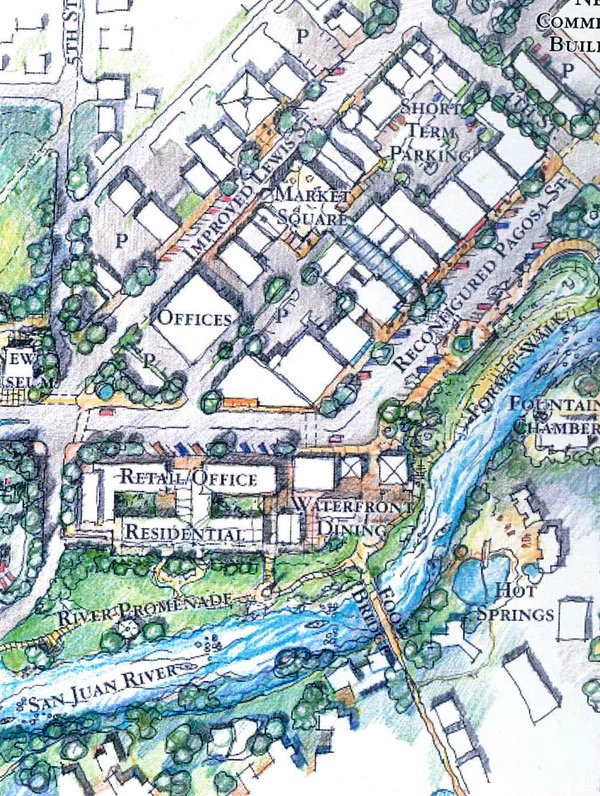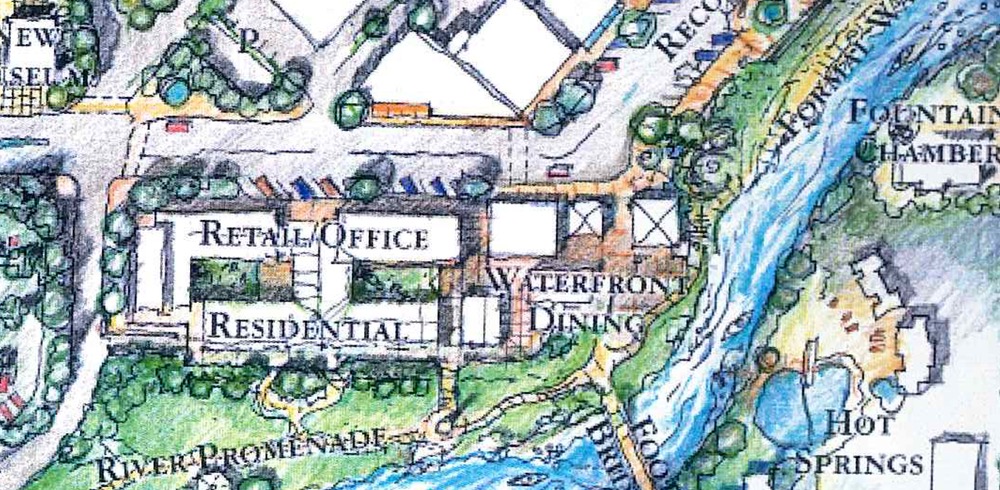As we noted yesterday in Part One, the Town Council had originally included the Archuleta County Courthouse in the “Historic Preservation Overlay District” created in 2004, with an eye to keeping downtown Pagosa looking somewhat… well, “historical.” Many other Colorado mountain towns had been making an effort to preserve the “authentic Wild West” movie-set appearance so attractive to a certain type of tourist. Here in Pagosa Springs, any historic buildings still remaining had done a fairly decent job of preserving themselves without government interference. That situation changed in 1999, when the Historic Preservation Board was created by the Town Council — and the 2004 “Historic Preservation Overlay District” was a further attempt to keep Pagosa looking like Pagosa.
The 2004 attempt at government control applied only to the central business district, however, which consisted — in the opinion of the Town Council — of the buildings on both sides of the 400 block of Lewis Street, and the buildings on the north side of the 400 block of Pagosa Street, also known as Main Street.
Plus the County Courthouse. We mustn’t forget the County Courthouse.

The rest of the downtown, from the River Center area to the east, all the way up Putt Hill to the west, was expected to continue fending for itself, in terms of claiming any historical importance.
Many of the buildings originally included in the ‘Historic District’ date from the 1950s or later; some of the facades date from the 1990s. The Methodist Church, for example, was substantially remodeled in 2009, as was the Momentum Fitness building two doors away. A cheap metal building was erected across the street from the Methodist Church, also in the 1990s. That is to say, the downtown core is an eclectic mix of old and new, with no real “historical theme” unifying its appearance.
Then, in 2007… the Archuleta County government discovered a slight bookkeeping error. It seemed that, somehow, $2.8 million shown in the County’s accounting records had disappeared, or maybe was never there in the first place. (The public was never provided a convincing explanation for the missing money.) As the disaster unfolded, the state government was threatening to step in and assume control of the County administration, which as you can imagine was a disturbing idea to the Board of County Commissioners.
It just so happened that a developer named David Brown had just finished demolishing the older (non-historical) buildings on the lot adjacent to the Courthouse, to the west, and had presented the Town government with sketches of a ‘revitalized’ downtown concept that showed — among other changes — the County Courthouse parcel and the adjoining (now vacant) parcel graced with a big, new building that included “retail” on the street side and “residential” on the river side, plus some “waterfront dining.” Here’s a detail of the sketch, which roughly corresponds to the area of downtown shown above in the “Historic Overlay” map.

It seemed, for a moment, as if the County’s 2007 budget crisis might be a real opportunity for Mr. Brown. If the County would be willing to sell their (historic) Courthouse, it might help solve their serious budget shortfall, while also facilitating a key development that Mr. Brown had in mind as part of his “revitalization’ plans. And indeed, an offer was placed before the BOCC. According to news reports, Mr. Brown had offered $1.4 million for the Courthouse, contingent upon a BOCC promise to move into a replacement courthouse elsewhere within six years. (The cost for a new building was estimated at $22 million.)
The plan, obviously, would be to demolish the Courthouse… one of the few truly “historic” buildings left in Pagosa.
In order to facilitate this sale, the Town Council met in May, 2007, and passed Ordinance 633, excluding the Archuleta County Courthouse from the “Historic Preservation Overlay District.” Shortly after that vote, the Town published a new map of the “Historic Business District.” I’ve colorized it and indicated the County Courthouse in pink.

Things seemed to be falling into place for the demolition of the old Courthouse.
But a month later, the three County Commissioners unanimously rejected David Brown’s offer to purchase the Courthouse, for their various reasons. (They were, after all, in the midst of a financial crisis, with no light yet visible at the end of the tunnel.)
Over the next decade, the County slowly recovered from its financial crisis, and began stashing millions of dollars into “strategic” bank accounts, to be accessed only if another financial crisis should occur. In the meantime, the idea that the Courthouse ought to be, someday, sold and demolished and replaced with a brand new County Courthouse, remained central to BOCC’s planning processes. The community as a whole was also digging itself out of a financial hole created by the Great Recession and a serious local housing bubble.
The local economy began to feel healthy again, but the Courthouse building itself came under attack as decidedly “unhealthy.” Conflicting scientific interpretations of air quality data pointed to a facility that was either dangerous to human life… or else absolutely nonthreatening.
You can read about that controversy here.
Curiously enough, this desperate debate about air quality was unfolding just a few weeks before a planned vote on a County sales tax increase. The BOCC had determined in 2017 that the time had arrived to ask the community’s voters for a sales tax increase that would have generated in excess of $44 million (according to the ballot language and my pocket calculator) to be used for “justice center capital improvements.”
The voters turned down that proposed tax increase in 2017.
Then, they turned it down again in 2018, while approving a tax increase for local school funding.
This year, the BOCC — Ronnie Maez, Steve Wadley and Alvin Schaaf — decided to hijack revenues from other County services, including Road & Bridge, for the next 15 years or so, to build a jail facility without voter approval.
But the old (historic?) Courthouse remains standing… two years after being declared uninhabitable by County Sheriff Rich Valdez and also by the Sixth Judicial District… and continues to be occupied by the County Assessor, County Treasurer and County Clerk & Recorder and their respective staff members, without any reported deaths from poor air quality.
Read Part Three…

